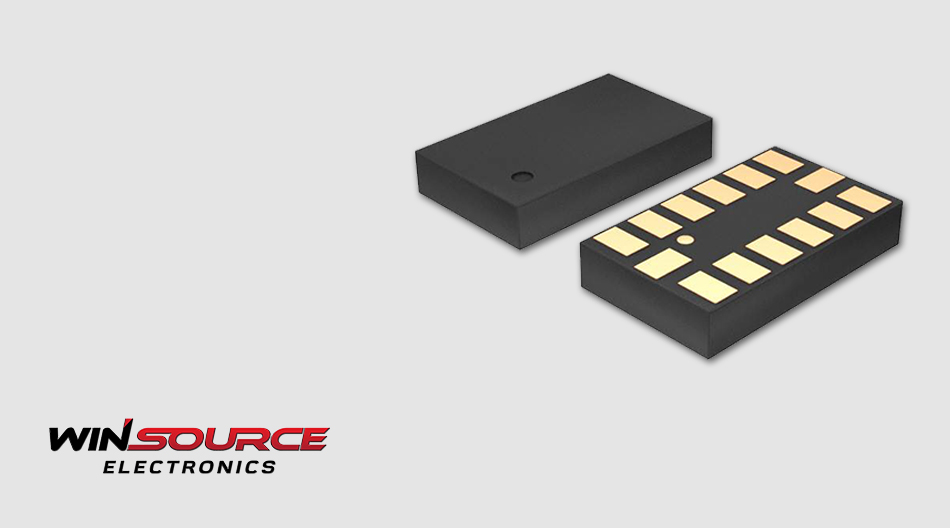
As smart devices, wearable products, and IoT terminals continue to expand, sensors are playing an increasingly critical role in system design. Engineers today not only require accurate and stable acceleration data, but also demand smaller footprints, lower power consumption, and more flexible data-processing capabilities.
Under these market needs, the LIS2DE12TR from STMicroelectronics has become a preferred option for lightweight and ultra-low-power designs. This article provides a detailed look at its technical features, system-level benefits, and application value to help engineering teams better understand the full potential of this device.
1. Compact Package: Optimized for Lightweight and Space-Constrained Designs
The LIS2DE12TR adopts a 2 × 2 × 1 mm LGA package, making it one of the most compact 3-axis accelerometers available today. Its small footprint not only reduces PCB area, but also gives designers greater integration freedom in ultra-compact products.
In wearables, earbuds, micro-tracking tags, and medical sensor patches—where internal space is extremely limited—this miniature package helps reduce overall device size and weight. It also simplifies PCB layout planning and is ideal for building multi-sensor modules that combine various MEMS components.
2. Ultra-Low-Power Architecture: A Core Enabler for Long-Battery-Life Devices
The LIS2DE12TR stands out for its flexible and highly efficient power-management design. According to the ST data sheet, the device operates at a typical current of around 2 μA in Low-Power mode with a 1 Hz output data rate (ODR), with the actual current varying depending on the selected mode and data rate. Compared with traditional three-axis accelerometers, this configurable power architecture significantly reduces the energy burden on battery-powered systems.
Its low-power advantages are reflected in several key technical features:
Multiple operating modes: Low-Power, Normal, and High-Resolution modes allow engineers to balance power consumption and signal quality. For example, background monitoring can run in low-power mode, while high-accuracy measurements can be performed in high-resolution mode when needed.
Interrupt-driven wake-up mechanism: The sensor can monitor motion patterns in the background at a low data rate and only trigger an interrupt when a predefined condition is met. This reduces the need for frequent MCU polling and lowers system-level power consumption.
FIFO buffer to reduce communication frequency: The integrated FIFO stores batches of acceleration data, allowing the MCU to access information less frequently, further enhancing overall power efficiency.
For power-sensitive applications such as health-monitoring wearables, Bluetooth Low Energy (BLE) tags, smart remote controllers, and environmental sensing nodes, this adjustable low-power architecture helps significantly extend battery life and supports lightweight, low-duty-cycle data acquisition systems.
3. Motion Detection Capabilities: Hardware-Based Event Recognition
Beyond providing three-axis acceleration measurements, the LIS2DE12TR incorporates several hardware-level event-detection features. These functions rely on built-in threshold logic and do not require complex algorithms or continuous MCU involvement, enabling lightweight event triggering in resource-constrained systems.
The integrated event-detection capabilities include:
Motion / inactivity detection: By configuring thresholds and timing parameters, the device can determine whether it is in motion or at rest. This is useful for power-management schemes and automatic mode switching.
Free-fall detection: When acceleration falls within a defined low-magnitude range, the device generates an interrupt. This feature supports logistics drop detection, fall-response mechanisms, and similar applications.
4D / 6D orientation detection: Based on gravity-vector analysis, the sensor can identify basic changes in device orientation, such as flipping or transitions between horizontal and vertical positions—commonly used for screen orientation and simple motion awareness.
Threshold-based acceleration interrupts: When acceleration exceeds a programmable threshold, an event is triggered. This supports applications such as tap detection, vibration alerts, or abnormal shock monitoring.
These hardware-driven detection mechanisms allow the device to perform essential motion analysis without constant MCU activity, reducing system load and enabling event-driven, low-power designs. Whether used for gesture wake-up in wearables, lightweight vibration monitoring in industrial devices, or low-power trigger functions in IoT nodes, the LIS2DE12TR delivers reliable event recognition with minimal resource consumption.
4. Flexible Interfaces and Configuration: Simplifying System Integration
To support system integration, the LIS2DE12TR provides I²C and SPI digital interfaces, ensuring high compatibility with mainstream MCU ecosystems. The device’s register map is straightforward, offering flexible configuration options, including:
- Selectable full-scale ranges (±2g to ±16g)
- Wide output data-rate options from a few hertz to several kilohertz
- High-pass filtering, interrupt filtering, and multiple operating modes
- Various FIFO operating modes (Bypass, FIFO, Stream, etc.)
Such flexibility allows developers to tailor performance and power consumption based on real-world requirements, enabling systems to achieve the ideal balance between responsiveness and efficiency. For companies continuously iterating their products, this “scalable design” approach supports both current application needs and future feature expansion.
5. Proven Application Scenarios Across Multiple Industries
Thanks to its compact package, low-power architecture, and event-detection capabilities, the LIS2DE12TR has been widely adopted in various sectors:
Wearables and Smart Health Devices
Supports step counting, gesture detection, light-touch interactions, and fall detection.
IoT Devices and Wireless Sensor Nodes
Its ultra-low-power operation offers strong advantages in sleep monitoring, environmental sensing, and battery-powered gateways.
Industrial Vibration and Equipment Monitoring
Continuous measurement and threshold interrupts enable lightweight machine-health detection.
Smart Home and Consumer Electronics
Device orientation, shake-to-wake, and motion-triggered interaction can be implemented with low system cost.
Whether the design priority is compact size or power efficiency, the LIS2DE12TR offers a well-balanced and highly adaptable solution.
Overall, the LIS2DE12TR combines low power consumption, compact packaging, broad compatibility, and rich event-detection capabilities to meet the shared needs of today’s smart devices for miniaturization, efficiency, and high reliability. For engineering teams seeking stable supply, rapid integration, and long product lifecycles, it stands out as a mature and dependable choice.
As a professional distributor deeply engaged in the global electronic-component supply chain, WIN SOURCE provides long-term availability, technical support, and supply-chain stability for LIS2DE12TR and a wide range of MEMS sensors, helping customers accelerate development and enhance production efficiency.
© 2025 Win Source Electronics. All rights reserved. This content is protected by copyright and may not be reproduced, distributed, transmitted, cached or otherwise used, except with the prior written permission of Win Source Electronics.

COMMENTS